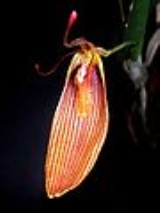
Restrepia antennifera
Encyclopedia
Restrepia antennifera, the Antennae-carrying Restrepia, is an epiphytic
, miniature species of orchid found at higher altitudes in cool, moist montane forests in Venezuela
, Colombia
and Ecuador
.
These tiny orchids lack pseudobulb
s. The erect, thick, leathery leaf
is elliptic-ovate in shape. The aerial root
s seem like fine hairs.
The attractive flower
s are 5–6 cm long. They develop one at a time at the base of the leaf. They are borne on a slender peduncle
, originating from the base of the back of the leaf. The long dorsal sepal
is erect, triangular at the base and ends in a somewhat thicker club-shaped tip (= clavate). They have fused lateral sepals (synsepals) which may be quite colorful : yellow, orange or tan with contrasting maroon lengthwise stripes. The long, slender, lateral petal
s equally end in a thickened club-shaped tip. The long lip
is ovoid and widest at its apex. It shows a reddish lengthwise stripe. In rare cases, the synsepals may split, resulting in two separate sepals. The column has four pollinia
.
Restrepia antennifera is well-known to orchid growers, although many other Restrepias are misidentified as "antennifera". The flower blooms for 1 to 2 weeks. They flower again and again in sequential order from the same growth.
Epiphyte
An epiphyte is a plant that grows upon another plant non-parasitically or sometimes upon some other object , derives its moisture and nutrients from the air and rain and sometimes from debris accumulating around it, and is found in the temperate zone and in the...
, miniature species of orchid found at higher altitudes in cool, moist montane forests in Venezuela
Venezuela
Venezuela , officially called the Bolivarian Republic of Venezuela , is a tropical country on the northern coast of South America. It borders Colombia to the west, Guyana to the east, and Brazil to the south...
, Colombia
Colombia
Colombia, officially the Republic of Colombia , is a unitary constitutional republic comprising thirty-two departments. The country is located in northwestern South America, bordered to the east by Venezuela and Brazil; to the south by Ecuador and Peru; to the north by the Caribbean Sea; to the...
and Ecuador
Ecuador
Ecuador , officially the Republic of Ecuador is a representative democratic republic in South America, bordered by Colombia on the north, Peru on the east and south, and by the Pacific Ocean to the west. It is one of only two countries in South America, along with Chile, that do not have a border...
.
These tiny orchids lack pseudobulb
Pseudobulb
The pseudobulb is a storage organ derived from the part of a stem between two leaf nodes.It applies to the orchid family , specifically certain groups of epiphytic orchids, and may be single or composed of several internodes with evergreen or deciduous leaves along its length.In some species, it is...
s. The erect, thick, leathery leaf
Leaf
A leaf is an organ of a vascular plant, as defined in botanical terms, and in particular in plant morphology. Foliage is a mass noun that refers to leaves as a feature of plants....
is elliptic-ovate in shape. The aerial root
Root
In vascular plants, the root is the organ of a plant that typically lies below the surface of the soil. This is not always the case, however, since a root can also be aerial or aerating . Furthermore, a stem normally occurring below ground is not exceptional either...
s seem like fine hairs.
The attractive flower
Flower
A flower, sometimes known as a bloom or blossom, is the reproductive structure found in flowering plants . The biological function of a flower is to effect reproduction, usually by providing a mechanism for the union of sperm with eggs...
s are 5–6 cm long. They develop one at a time at the base of the leaf. They are borne on a slender peduncle
Peduncle (botany)
In botany, a peduncle is a stem supporting an inflorescence, or after fecundation, an infructescence.The peduncle is a stem, usually green and without leaves, though sometimes colored or supporting small leaves...
, originating from the base of the back of the leaf. The long dorsal sepal
Sepal
A sepal is a part of the flower of angiosperms . Collectively the sepals form the calyx, which is the outermost whorl of parts that form a flower. Usually green, sepals have the typical function of protecting the petals when the flower is in bud...
is erect, triangular at the base and ends in a somewhat thicker club-shaped tip (= clavate). They have fused lateral sepals (synsepals) which may be quite colorful : yellow, orange or tan with contrasting maroon lengthwise stripes. The long, slender, lateral petal
Petal
Petals are modified leaves that surround the reproductive parts of flowers. They often are brightly colored or unusually shaped to attract pollinators. Together, all of the petals of a flower are called a corolla. Petals are usually accompanied by another set of special leaves called sepals lying...
s equally end in a thickened club-shaped tip. The long lip
Labellum
Labellum is the Latin diminutive of labium, meaning lip. These are anatomical terms used descriptively in biology, for example in Entomology and botany.-Botany:...
is ovoid and widest at its apex. It shows a reddish lengthwise stripe. In rare cases, the synsepals may split, resulting in two separate sepals. The column has four pollinia
Pollinium
Pollinium, or plural pollinia, is a coherent mass of pollen grains in a plant.They are the product of only one anther, but are transferred, during pollination, as a single unit. This is regularly seen in plants such as orchids and many species of milkweeds .Most orchids have waxy pollinia...
.
Restrepia antennifera is well-known to orchid growers, although many other Restrepias are misidentified as "antennifera". The flower blooms for 1 to 2 weeks. They flower again and again in sequential order from the same growth.

